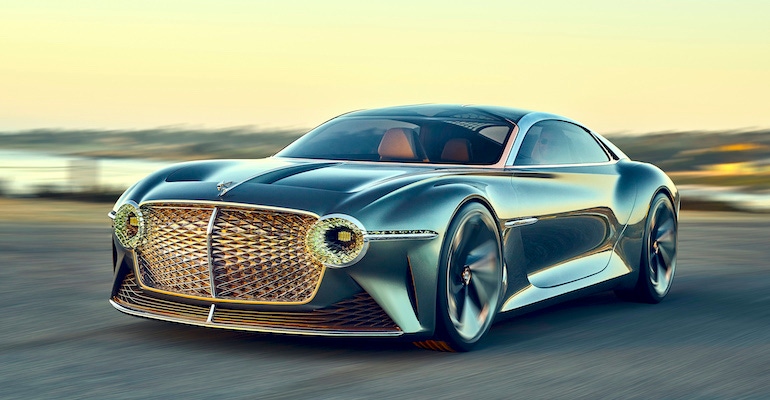Bentley Aims for Rare Earth-Free EV Production by 2026
Bentley Motors' OCTOPUS project is targeting the development of electric motors for future EVs like the EXP 100 GT that won't need copper or rare earth metals.

Bentley Motors recently retired the company’s classic V8 engine design after 61 years of service, and while it has some combustion replacements for the near term, the company’s OCTOPUS research project aims to produce an EV drivetrain with the same superb fundamentals as that long-running V8.
The company will need electric drive for its traditional models, because what could be smoother and quieter than an electric limousine? But we’re looking forward to cars like the exotic EXP 100 GT EV concept car that Bentley teased last year as a future vision of today’s Continental GT.

For the old combustion engine, those fundamentals included a deep-skirted aluminum block that provided a solid foundation. Future electric motors need to be designed to avoid using expensive and fraught rare earth metals to give them a solid sustainable foundation.
That’s the goal of OCTOPUS (Optimized Components, Test and simulatiOn, toolkits for Powertrains which integrate Ultra high-speed motor Solutions). This project follows an 18-month study that confirmed the viability of plans to exceed the performance of today’s permanent magnet motors without using rare earth magnets or copper windings. The attributes not only contribute to responsible sustainability but reduce cost and improve end-of-life recyclability.
The Octopus project will expand on that research, integrating that leading-edge motor power electronics and packaging transmission design with next-generation materials, manufacturing processes, simulation, and test cycles to produce a Bentley-level drivetrain by 2026.
“We have made no secret of our ambition to lead the way in the delivery of sustainable luxury mobility, Beyond100,” stated Stefan Fischer, Director of Powertrain Engineering at Bentley Motors. “We have a clear roadmap to offer a hybrid option for every model by 2023, starting with the Bentayga Hybrid, and our next goal moves towards a fully electric Bentley by 2026.”
However, there are hurdles to be cleared before the company can deliver a production version of the lovely EXP 100 GT to anxious customers. “Today, there remains challenges and package constraints on the viability and flexibility of electric vehicle powertrains that are able to fully support EV architectures,” Fischer conceded. “With the industry, technologies, and cars changing faster than ever before, research projects such as OCTOPUS are crucial to deliver innovative technologies and overcome challenges for the next generation of mobility solutions.”
To achieve this, Bentley has partnered with U.K. technology leaders on OCTOPUS. The participants and their responsibilities are:
Bentley Motors – Specification setting, vehicle integration plan, and system test
Advanced Electric Machines Ltd – Motor manufacturing and systems assembly
Advanced Electric Machines Research Ltd – Motor and transmission design
The Thinking Pod Innovations Ltd & Nottingham University – Power electronics optimization and alternative wide-band gap system design
The Institute for Advanced Automotive Propulsion Systems (IAAPS) at the University of Bath – Integrated system analysis and proof of concept validation testing
HiETA Technologies Ltd – Additive manufacturing component design and manufacture for thermal management including stator core housing, power electronics, and E-axle oil cooling
FD Sims Ltd – Next-generation wire technology development
Talga Technologies Ltd – 2D materials development for next-generation winding technologies
Diamond Light Source – UK’s national synchrotron light source providing access to X-ray facilities for measurements
Hartree Centre (Science and Technology Facilities Council) – Advanced system testing and co-simulation toolkit development
Partner Advanced Electric Machines provides a little more detail on the contributions from various participants:
The Diamond Light Source, the UK's most powerful x-ray source, will scan inside the motor as it spins at up to 30,000 rpm to monitor it in action.
AEMR will use Europe’s most powerful supercomputer that is available to industry to model all the details of the motor, power electronics, and transmission system as they operate.
The academics at the University of Bath and University of Nottingham are tasked with providing the latest thinking in test and simulation.
Hieta, Talga, and FD Sims will contribute the latest materials and manufacturing techniques to deliver even lower weight and higher performance.
TTPi’s job is to deliver an integrated power electronics system. And AEMR is toiling to wring still more efficiency and torque from its already market-leading electric motor design.
“Having already worked closely with Bentley to successfully deliver a proof of concept, we look forward to this new project to push the performance, packaging, and sustainability of electric vehicle drives to a new level, removing the need for rare-earths and copper and achieving the highest levels of system integration,” said Advanced Electric Machines Group CEO, Dr. James Widmer.

All that’s left for the rest of us to do is wait to see the final version of the EXP 100 GT in 2026.
About the Author(s)
You May Also Like





